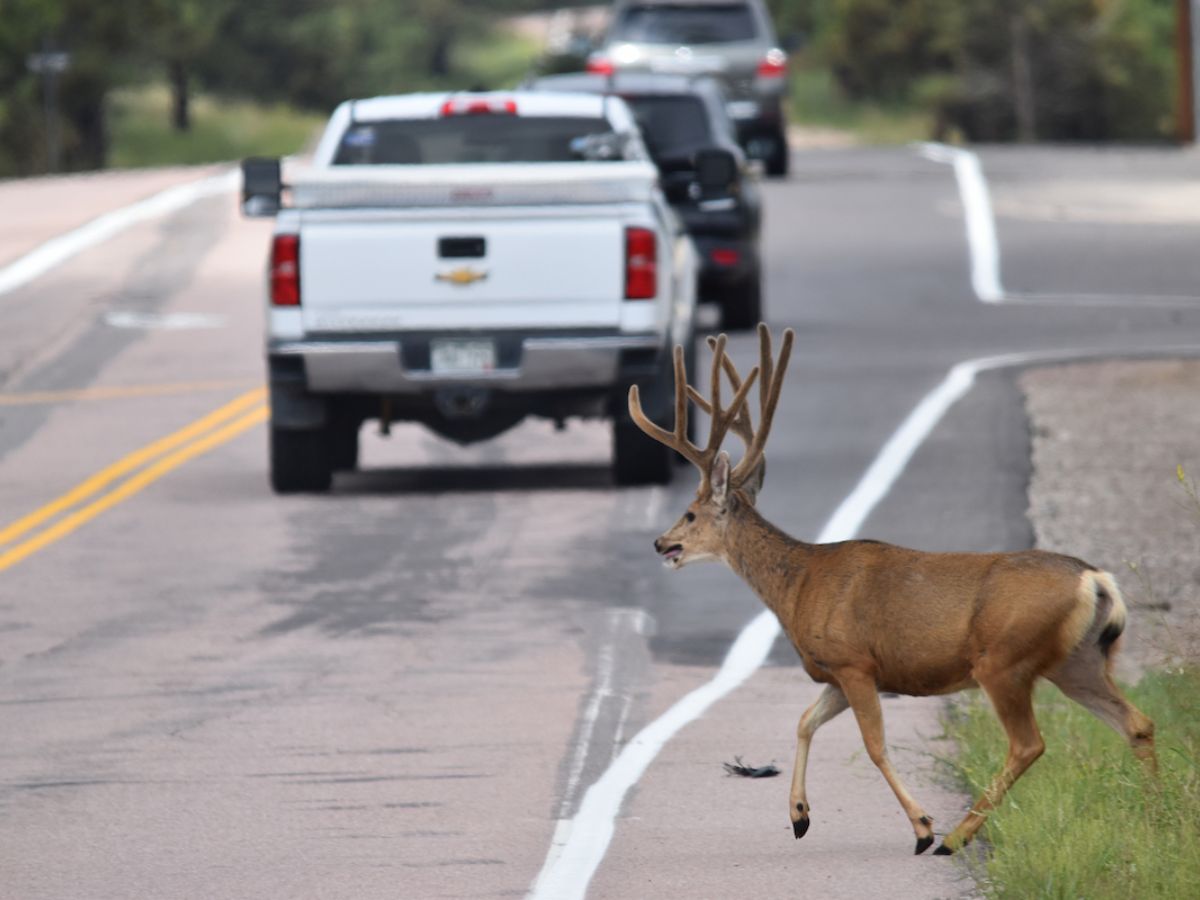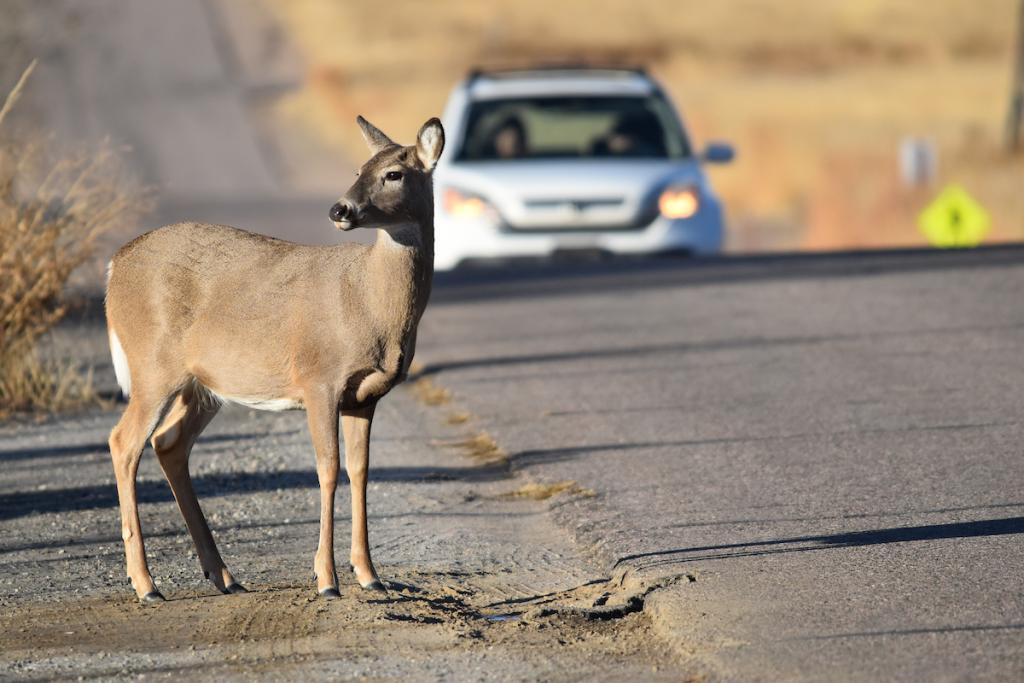Watch for Wildlife on Roads During Daylight Saving Time Transition

Description: The Colorado Parks and Wildlife Released the Following Tips for Avoiding Wildlife Collisions During the Daylight Saving Time Transition.

Watch for Wildlife on Roads During Daylight Saving Time
Changing your clocks and driving habits during daylight saving time can help prevent wildlife-vehicle collisions. Wildlife and transportation experts advise Colorado drivers that wildlife is on the move, so be aware, drive with caution and slow down at night.
This Sunday, Nov. 3, 2024, marks the end of daylight saving time, which means people will set their clocks back an hour, see dusk earlier and see more wildlife migrating to wintering habitats during rush-hour traffic on roadways.
Colorado Parks and Wildlife (CPW), Colorado Department of Transportation (CDOT) and Colorado State Patrol ask drivers to drive cautiously as winter storms push wildlife from the high country into lower elevations.
-
Slow down. Traveling at high speeds increases the danger of a crash. Moderate speeds maintain a driver’s reaction time and allow an appropriate response to animals on or near roads.
-
Stay alert. Pay close attention to the roadway between dusk and dawn, when deer and other wildlife are most active and crossing roadways.
-
Scan ahead. Watch for movement and shining eyes along roadsides. If you see one animal, you should expect others to be in the area.
-
Obey traffic signs. Many highways have wildlife warning signs intended to alert motorists of known wildlife movement areas. Transportation authorities attempt to reduce the number of wildlife-vehicle collisions by posting signage and lowering speeds in areas where wildlife is active.
-
Give warning. Slow down or stop when animals are seen on or near the road (if no other cars are behind you). Honk the horn and flash headlights to warn the animal to avoid the road and alert drivers to the potential hazard.
-
Avoid swerving. Never swerve or jerk the wheel of your car. Swerving can cause you to lose control, drive into another vehicle or drive off the road.
-
Always wear seat belts. Unfortunately, not every collision is avoidable. The risk of serious injury and death in a crash is reduced by half when seat belts are worn.
-
Report collisions. Drivers involved in a wildlife-vehicle collision should report the accident to the Colorado State Patrol by calling *CSP (star key and 277).

“It can be extremely difficult to see deer and other wildlife along the highway when it’s dark out. So drive the speed limit and concentrate on the road,” said Col. Matthew C. Packard, chief of the Colorado State Patrol. “Our troopers and CDOT maintenance crews are called out daily about animal-vehicle collisions and carcasses on the roadway. We see and respond to thousands of wildlife-vehicle collisions throughout the year.”
Wildlife mitigation features are frequently added to planned highway improvement projects to help decrease the number of wildlife-vehicle collisions in Colorado. CPW and CDOT actively monitor wildlife data to identify potential highway mitigation projects that can protect wildlife on the move and keep motorists safe. Collaboration between the agencies has led to developing wildlife prioritization plans for the Western Slope and the Eastern Slope and Plains. To learn more, visit the Colorado Wildlife Transportation Alliance webpage.
“Many of our highway construction projects now incorporate wildlife mitigation features where they are needed most,” explained CDOT Chief Engineer Keith Stefanik. “Animal underpasses, overpasses, deer fencing, jump outs and deer guards are structures that can help funnel and direct large game and even smaller wildlife to cross from one side of the highway to the other in a safe manner for both motorists and the animals.”
Projects recently completed or under construction include:
-
I-70 Genesee (one underpass and high fencing)
-
US 550 Billy Creek (one underpass with high fencing and tied to two previously completed mitigation projects)
-
I-25 Greenland overpass planned for 2025 (in addition to five underpasses already constructed with high fencing)
-
I-70 West Vail Pass is scheduled for 2025 (two large underpasses, four small mammal culverts and high fencing)
"Colorado has had great success with constructing wildlife crossings in areas with the greatest need. However, all across the state, wildlife is on the move and crossing roads,” said CPW Wildlife Movement Coordinator Michelle Cowardin. “It is important for motorists to watch for wildlife on the move, not be distracted, and obey speed limits to minimize their risk of an accident with wildlife."
Stay Informed:
-
Colorado Parks and Wildlife website at cpw.state.co.us/wildlife-migration-and-movement
-
Colorado State Patrol website at csp.colorado.gov
-
CDOT’s Wildlife Program webpage at codot.gov/programs/environmental/wildlife
Follow SECO News on Facebook.
Subscribe to the SECO News YouTube Channel.
Press releases Sponsor






.png)






.png)
.png)


.png)







